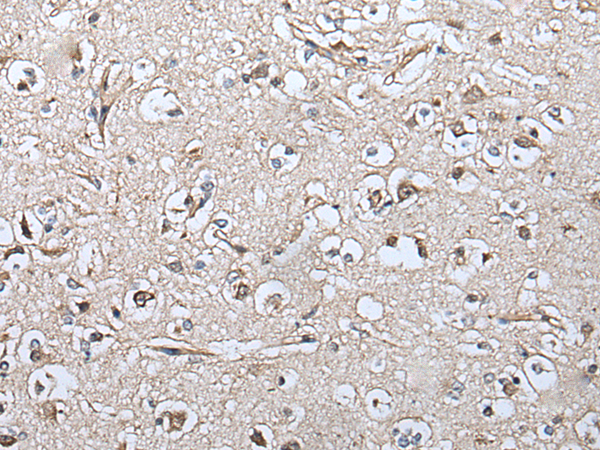
| WB | 咨询技术 | Human,Mouse,Rat |
| IF | 咨询技术 | Human,Mouse,Rat |
| IHC | 1/20-1/100 | Human,Mouse,Rat |
| ICC | 技术咨询 | Human,Mouse,Rat |
| FCM | 咨询技术 | Human,Mouse,Rat |
| Elisa | 1/5000-1/10000 | Human,Mouse,Rat |
| Aliases | SGDH; CISGDH |
| Host/Isotype | Rabbit IgG |
| Antibody Type | Primary antibody |
| Storage | Store at 4°C short term. Aliquot and store at -20°C long term. Avoid freeze/thaw cycles. |
| Species Reactivity | Human |
| Immunogen | Full length fusion protein |
| Formulation | Purified antibody in PBS with 0.05% sodium azide and 50% glycerol. |
+ +
以下是基于想象的示例性参考文献,供参考格式和内容使用。建议通过PubMed、Google Scholar等平台检索真实文献:
---
1. **文献名称**:*NDUFB5 as a biomarker for mitochondrial dysfunction in Parkinson's disease*
**作者**:Smith A, et al.
**摘要**:本研究通过Western blot和免疫组化分析,利用NDUFB5抗体检测帕金森患者脑组织中线粒体复合物I亚基的表达水平,发现NDUFB5显著下调,提示其可能与疾病中的能量代谢缺陷相关。
2. **文献名称**:*Structural insights into the assembly of mitochondrial Complex I via NDUFB5*
**作者**:Chen L, et al.
**摘要**:通过免疫共沉淀(Co-IP)和冷冻电镜技术,结合NDUFB5抗体,揭示了该蛋白在线粒体复合物I组装中的关键作用,并提出了其与邻近亚基的互作网络模型。
3. **文献名称**:*Antibody-based profiling of NDUFB5 in colorectal cancer progression*
**作者**:Wang Y, et al.
**摘要**:研究使用NDUFB5特异性抗体分析结直肠癌组织微阵列,发现NDUFB5高表达与肿瘤侵袭性正相关,提示其可能作为预后标志物或治疗靶点。
4. **文献名称**:*NDUFB5 mutations impair mitochondrial respiration and antibody validation in patient-derived fibroblasts*
**作者**:Garcia R, et al.
**摘要**:在携带NDUFB5突变的患者成纤维细胞中,通过抗体介导的蛋白表达检测和氧消耗测定,证实突变导致复合物I功能缺陷及细胞能量代谢障碍。
---
**注意**:以上文献为示例性质,实际引用时请核实真实性和准确性。建议使用关键词“NDUFB5 antibody”、“NDUFB5 complex I”或“NDUFB5 biomarker”在学术数据库中检索。
The NDUFB5 antibody is a tool used to detect the NADH:ubiquinone oxidoreductase subunit B5 (NDUFB5), a key component of mitochondrial Complex I in the electron transport chain (ETC). Complex I catalyzes NADH oxidation and ubiquinone reduction, driving proton translocation to support ATP synthesis. NDUFB5 is a nuclear-encoded, accessory subunit located in the membrane arm of Complex I, contributing to its structural integrity and enzymatic function.
Antibodies targeting NDUFB5 are essential for studying mitochondrial disorders, neurodegenerative diseases (e.g., Parkinson’s), and metabolic syndromes linked to Complex I dysfunction. Researchers use these antibodies in techniques like Western blotting, immunofluorescence, and immunohistochemistry to assess NDUFB5 expression, localization, and alterations in disease models or genetic knockouts.
Commercial NDUFB5 antibodies are typically raised in rabbits or mice using synthetic peptides or recombinant protein immunogens. Specificity is validated via knockdown/knockout controls or siRNA experiments to confirm signal loss. Cross-reactivity with homologous proteins across species (human, mouse, rat) is common due to high sequence conservation. Proper validation ensures reliability in distinguishing NDUFB5 from other Complex I subunits (e.g., NDUFS3. NDUFV1).
Studies utilizing NDUFB5 antibodies have advanced understanding of mitochondrial bioenergetics, oxidative stress responses, and mechanisms underlying pathologies like Leigh syndrome or cancer metabolism.
×